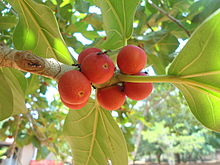Ficus benghalensis
The banyan tree (Ficus benghalensis), a common name it shares with other species of the genus Ficus, is a tree endemic to Bangladesh, India and Sri Lanka.
Description
It can grow into a giant tree that spans several acres. Ficus benghalensis produces aerial roots on branches that grow downward like lianas. Once these roots reach the ground, they take root and become woody and supporting, they become stilt roots.
It receives other more suggestive names, for example banyan tree, fig tree or strangler fig tree. The fig thing is due to the fact that it is also from the fig family and the strangler part because it begins as an epiphyte, that is, leaning on another tree that it ends up suffocating. From this fact also comes another name of many species of Ficus with which it is known in Venezuela and in other American countries: that of matapalo.
Ecology
This plant is native to India and Ceylon (Sri Lanka). Banyans, like the different species of matapalos, reproduce easily by seed or by cutting, and often spread from their original location by means of aerial roots that anchor into the soil and begin to grow and thicken to the point where they "independent" of the original trunk, thus achieving "migrate" sometimes at great distances, as seen in the image taken in Caracas. In said image, it can be seen how the original trunk of a banyan tree leans towards the street (Avenida La Salle in Caracas) developing numerous roots that can be welded and become trunks that serve as supports, with which they can reach a certain distance until they reach a place where there is a greater degree of insolation, in this case, the avenue itself, away from the buildings on both sides of it. It is a simple adaptation to very complex ecological conditions.
It is pollinated by wasps of figs of the genera Pegoscapus or Pleistodontes.
The seeds of the banyan trees can fall and grow near a tree, sometimes the tree itself where they come from, and they also usually fructify in a hole in a trunk or a wall or rock. Little by little they begin to grow since they have a great ability to lean as epiphytes on any object that helps them ascend in search of the sun's rays. Under normal conditions, the tree grows until it reaches a level where it gets the most sunlight, so its height can vary considerably. For this reason, where this tree predominates in a place, rather than growing in height, they spread out on the surface, looking for the clearings that remain without vegetation. In general, the crown of this tree extends over a diameter much greater than its height.
Origin of common name
Many Asian peoples socialize under the banyan trees, as it protects them from the sun's rays. People walk through their roots and branches, build temples, and put up markets. In fact, the name of banyan comes from the markets. Itinerant merchants were called banyan trees. As it was customary for them to put their stalls under these trees, the name of the trees was identified with that of the street vendors.
Uses
Buddhists and Hindus consider it a sacred tree. Buddha is said to have attained enlightenment sitting under a banyan tree. Medicines against leprosy and diabetes have been obtained from its fruits [citation needed]. The taste of the fruit is not very appealing to humans, but there are monkeys who love it [citation needed]. The same goes for bats and certain birds. Elephants eat its leaves with delight.
Famous Specimens
The most famous banyan tree is the one in the Calcutta Botanical Gardens. It is over 230 years old and occupies an area of 12,000 square meters; more or less a circle with a diameter of 120 m. The circumference of the main trunk is more than twelve meters.
Despite this fame, the Guinness Book of Records tells us that the largest is also in an Indian city, in the city of Kadiri. The tree in question is called ''Thimmamma Marrimanu''.
Thimmamma, according to the locals, is the name of a woman who saved her husband with her devotion. A local legend says that if a childless couple prays to Thimmamma under the tree, the following year they will have a child.
In Spain there are good examples of banyans, especially on the island of Tenerife and in Valencia, although nothing comparable to those of Calcutta or Kadiri.
In English it is called Banyan.
Taxonomy
Ficus benghalensis was described by Carlos Linnaeus and published in Species Plantarum 2: 1059–1060. 1753.
- Etymology
Ficus: generic name derived from the Latin name for fig.
benghalensis: geographical epithet that alludes to its location in Bengal.
- Sinonimia
- Ficus banyana Oken
- Ficus benghalensis var. krishnae (C.DC.) Corner
- Ficus chauvieri G.Nicholson
- Ficus cotoneifolia Vahl
- Ficus cotonifolia Stokes
- Ficus crassinervia Kunth & C.D.Bouché
- Ficus karet Baill.
- Ficus krishnae C.DC.
- Ficus lancifolia Moench
- Ficus lasiophylla Link
- Ficus procera Salisb.
- Ficus pubescens B. Heyne ex Roth
- Ficus umbrosa Salisb.
- Perula benghalensis Raf.
- Urostigma benghalense (L.) Gasp.
- Urostigma crassirameum Miq.
- Urostigma procerum Miq.
- Urostigma pseudorubrum Miq.
- Urostigma rubescens Miq.
- Urostigma sundaicum Miq.
- Urostigma tjiela Miq.
Contenido relacionado
Hominidae
Poliomyelitis
Trigynaea




